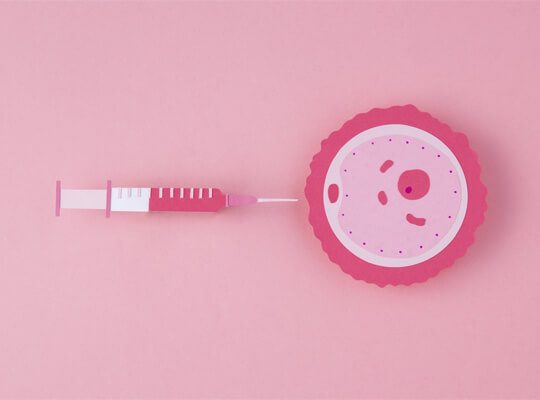ROPA (IVF and Reception of Oocytes from Partner)
Table of Contents
What is ROPA (Reception of Oocytes from Partner) method?
ROPA, which is a treatment method that involves the genetic mother who provides the egg to the baby and the biological mother who carries the pregnancy, makes it possible for women living in a homosexual relationship, transgender individuals who have their ovaries frozen before sex reassignment surgery, or bisexual couples to share the pregnancy during the IVF treatment process in Turkish Republic of North Cyprus. Also known as mutual IVF, it is possible for the same sexes to share the pregnancy process.
In the ROPA method, also known as maternity sharing, one of the same sexes donate her eggs and the other carries the embryo. In this way, the baby has both a genetic and a biological mother. The woman who donates her eggs undergoes a process of ovarian stimulation for the growth of the follicle, as in the standard IVF cycle.
After the treatment process of the genetic mother is completed, the eggs are transferred to the biological mother or to the mother who is defined as the carrier.
In the ROPA method, which is widely preferred in lesbian couples, it is also possible to change the definition between the woman who provides the egg and the woman who carries the baby (between genetic mother and biological mother) in case of a second baby plan.
In which situations is the ROPA method applied?
ROPA appeals to people who want to share the pregnancy process. With this method, one of the couples can be the genetic mother and the other the biological mother. The method is also preferred in cases of;
- Genetic or chromosomal abnormalities,
- Absence of oocyte,
- Changes in oocyte quality,
- Absence of ovaries or severe dysfunction,
- Failure in the previous fertility treatment.
What is ROPA procedure?
The woman whose eggs are collected in the ROPA method undergoes a standard IVF treatment process. In order to obtain the optimal level of eggs in the menstrual cycle, the ovaries are taken into the stimulation process. Treatment varies between 10-12 days. Again, as in IVF treatment, the patient is subjected to procedures such as USG scanning and hormone testing. After the follicles reach a significant size, the eggs are collected. The eggs collected within an average of 15 minutes are taken to the laboratory environment and combined with the sperm selected from the sperm bank. This technique is called ICSI.
What is pharmacological treatment?
The ROPA method makes it possible for women in a homosexual relationship to share the pregnancy. The woman who contributes to the oocytes goes through standard IVF treatment processes. Primarily, follicles are produced to obtain the optimal number of oocytes. After the follicles reach the desired level, matured eggs are taken from the ovaries.
What is sperm preparation?
During the sperm donor selection process, the sperm sample taken from an anonymous donor and stored by freezing is submitted to the selection of the expectant mother and then processed. After physical, psychological and analytical testing processes, a rigorous treatment protocol is created. Generally, maximum physical resemblance to the biological mother is preferred.

How is fertilization and embryo transfer carried out?
As with standard IVF treatment, embryos are taken into incubators to complete their development. Throughout the process, the embryologists involved adopt a rigorous and sensitive working approach. In order to measure the quality of embryos, criteria such as analysis of cell number and morphology are considered. After the embryos, which remain in the incubator for an average of five to six days, reach the blastocyst stage, the quality ones are made into a package and the freezing process is performed.
In order to increase the chance of attachment of the embryo the treatment process is started in the step of embryo transfer to the biological mother. To reach the desired level of endometrial thickness, it may be necessary to apply progesterone and oestrogen hormones. Frozen embryos are thawed and transferred if the uterus is ready for the desired implantation.
In order to detect pregnancy after the embryo transfer process, a beta-HCG blood test is applied 12 days after the transfer.
What is the ethics of in vitro fertilization with oocyte retrieval from the partner?
The ROPA method is a treatment that can be applied to both lesbian or bisexual couples and transgender men who hid their eggs before having sex reassignment surgery. Especially in transgender men, the female partner can get pregnant as a result of the combination of the sperm and the oocytes of the person concerned. ROPA, which is a legally recognized IVF treatment method in Turkish Republic of North Cyprus, may need different legal status and requirements in different countries.
What is the legal status of ROPA?
Although it is not included in the current legal provisions, it is possible to use the ROPA (Oocyte Retrieval from Partner) technique, which enables same-sex couples to have children. In particular, in countries that accept same-sex marriage, “Women will be able to use the techniques regulated by law, regardless of their marital status and sexual orientation.” statement is included. In some countries such as Spain, couples should be married in order to use the ROPA technique. In Turkish Republic of North Cyprus no marriage requirement.
How are the oocytes collected?
During the oocyte retrieval stage, the process of ovarian stimulation is performed to obtain a sufficient number of oocytes from the genetic mother. Afterwards, the endometrium is brought to the ideal level for embryo implantation. In the ovarian collection step with mild sedation, the follicles containing the the oocytes are removed by liquid aspiration method. This application, performed with transvaginal ultrasound, is a fast and easy procedure that does not require hospitalization. After the procedure, the expectant mother whose pregnancy was planned can continue her life normally.
Can a fertilized egg be transferred to another woman?
Embryos belong to the couple in ROPA treatment, unless any contraindication during pregnancy. In summary, any embryo can be transferred to both mothers during pregnancy. In this way, the chance of pregnancy is possible for both mothers.
Is the egg collection process painful?
During the embryo transfer and egg collection process, the expectant mother does not encounter any pain or suffering problems. This procedure, which is performed very easily and quickly, is painless.
For More Information
Please do not hesitate to contact us for more information on the subject.



